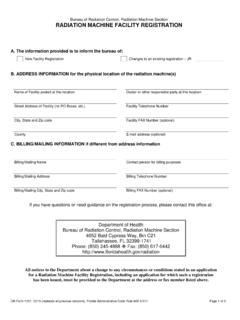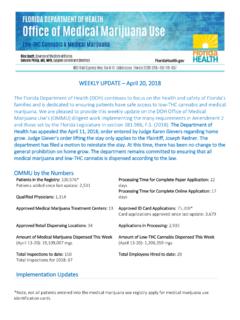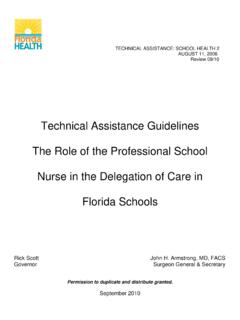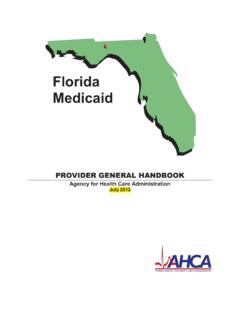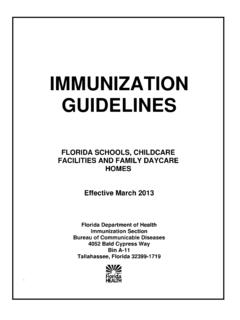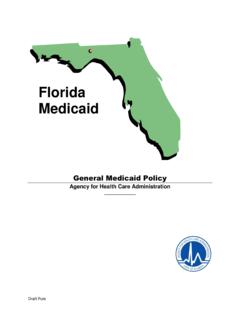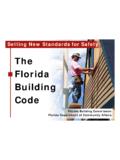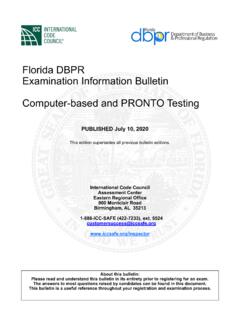Transcription of State of Florida
1 State OF Florida department OF health Bureau of Community Environmental health Chapter 64E-16, Florida administrative code Biomedical Waste General. Definitions. Facility Policies and Procedures. Storage and Containment . Labeling. Generator Requirements. Treatment. Transport. Registration of Transporters.
2 Inspections. Permits. Fees. Enforcement and Penalties. General. (1) This rule prescribes minimum sanitary practices relating to the management of biomedical waste, including segregation, handling, labeling, storage, transport, and treatment. This rule applies to all facilities that generate, transport, store, or treat biomedical waste to ensure that the waste is properly handled to protect public health .
3 Further, this rule prescribes minimum standards for permitting biomedical waste generators, storage facilities and treatment facilities, and for registering biomedical waste transporters. (2) This chapter does not apply to biomedical waste incinerators. This chapter does not apply to linen that is to be laundered and re-used. Further, this chapter does not apply to dead bodies that are disposed of by a person licensed under the provisions of Chapter 470, , or to the transport of bodies, parts of bodies, or tissue specimens in furtherance of lawful examination, investigation, or autopsy conducted pursuant to Section , Specimens or samples collected for laboratory testing or use in medical research or teaching are not considered biomedical waste until such time as the material is discarded.
4 (3) The department . of health shall regulate the packaging, transport, storage, and treatment of biomedical waste. The department of Environmental Protection shall regulate biomedical waste incineration and biomedical waste disposal. (4) health care providers shall inform their home user clients verbally and in writing of the recommended method for handling biomedical waste generated in the home setting. health care providers who deliver in-home medical services shall remove or have removed by a registered biomedical waste transporter all biomedical waste generated during the performance of these services. (5) Home users should segregate and package their biomedical waste in a manner that reduces the chance of exposure to the public.
5 (6) Inspections, permitting and enforcement of emergency medical services that generate biomedical waste shall be performed by the Bureau of Emergency Medical Services. Specific Authority , FS. Law Implemented , , (13), FS. History-New 6-19-89, Amended 12-14-92, 1-23-94, 6-3-97, Formerly Definitions. For the purpose of this chapter, the following words and phrases shall have the meanings indicated: (1) American Society for Testing Materials, also referred to as ASTM - A technical society with headquarters located at 100 Barr Harbor Drive, West Conshohocken, Pennsylvania, 19428-2959, which publishes national standards for the testing and quality assurance of materials.
6 (2) Biomedical waste - Any solid or liquid waste which may present a threat of infection to humans, including nonliquid tissue, body parts, blood, blood products, and body fluids from humans and other primates; laboratory and veterinary wastes which contain human disease-causing agents; and discarded sharps. The following are also included: (a) Used, absorbent materials saturated with blood, blood products, body fluids, or excretions or secretions contaminated with visible blood; and absorbent materials saturated with blood or blood products that have dried. (b) Non-absorbent, disposable devices that have been contaminated with blood, body fluids or, secretions or excretions visibly contaminated with blood, but have not been treated by an approved method.
7 (3) Biomedical waste generator - A facility or person that produces biomedical waste. The term includes hospitals, skilled nursing or convalescent hospitals, intermediate care facilities, clinics, dialysis clinics, dental offices, health maintenance organizations, surgical clinics, medical buildings, physicians offices, laboratories, veterinary clinics and funeral homes. (a) Mobile health care units, such as bloodmobiles, that are part of a stationary biomedical waste generator, are not considered individual biomedical waste generators. (b) Funeral homes that do not practice embalming are not considered biomedical waste generators.
8 (4) Body fluids - Those fluids which have the potential to harbor pathogens, such as human immunodeficiency virus and hepatitis B virus and include blood, blood products, lymph, semen, vaginal 1secretions, cerebrospinal, synovial, pleural, peritoneal, pericardial and amniotic fluids. In instances where identification of the fluid cannot be made, it shall be considered to be a regulated body fluid. Body excretions such as feces and secretions such as nasal discharges, saliva, sputum, sweat, tears, urine, and vomitus shall not be considered biomedical waste unless visibly contaminated with blood. (5) Contaminated - Soiled by any biomedical waste.
9 (6) Decontamination - The process of removing pathogenic microorganisms from objects or surfaces, thereby rendering them safe for handling. (7) department - The department of health or its representative county health department . (8) Disinfection - A process which results in a minimum Log 6 kill against the vegetative organisms listed in Table 1, and a minimum Log 4 kill against Bacillus Stearothermophilus spores utilizing steam or a minimum Log 4 kill against Bacillus Subtilis spores utilizing dry heat, chemicals, or microwave shredding. (9) Facility - All contiguous land, structures, and other appurtenances which are owned, operated, and licensed as a single entity which may consist of several generating, treatment, or storage units.
10 (10) Hazardous waste - Those materials defined in Chapter 62-730, (11) health Care Provider - Any person who provides medical care or personal services,as that term is defined in section , , to another individual. (12) Home User - An individual who generates biomedical waste as a result of self-care or care by a family member or other non health care provider. (13) Leak resistant - Prevents liquid from escaping to the environment in the upright position. (14) Outer container - Any rigid type container used to enclose packages of biomedical waste. (15) Packages - Any material that completely envelops biomedical waste.
